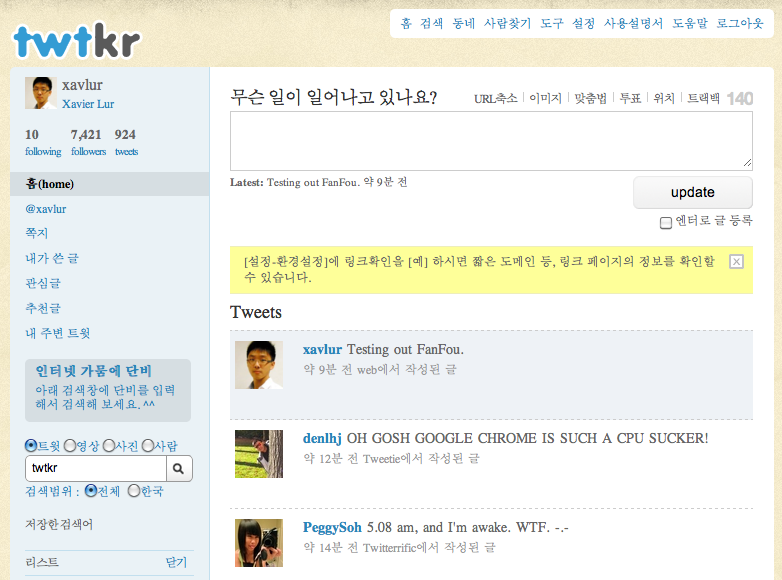
Twitter currently has five native tongues – English, Japanese, Spanish, French, and Italian. The world’s most popular micro-blogging even has plans to add German and Chinese into the list soon. Co-founder Jack Dorsey said last week during a New York gathering sponsored by ReadWriteWeb that it is just a matter of a time before Twitter will be serving the Chinese market despite numerous time-consuming obstacles to creating a Chinese Twitter, both political and technological.
*My friend Zhou Tong will be writing an intriguing article on TechXav soon of why it is impossible for Twitter to venture into the Chinese market, which has over 384 million Internet users. So stay tuned.
Meanwhile, avid Chinese and South Korean micro-blogging users have each developed a rather controversy website, which they both claim is a third-party Twitter client and is not affiliated with Twitter.com. The Chinese version one is called FanFou.im whereas the South Korean client is known as TwtKR.com. Unlike other English web-based Twitter clients such as iTweet 2, the design and layout of these so-called Twitter “clones” seem to be exact replicas of the original Twitter.com site.
Take a look at the screenshots below, and compare the two with Twitter.com’s. You can barely spot any major difference, especially for FanFou.im, which looks exactly (99.9 per cent) like Twitter.com. FanFou.im copies almost all of the features Twitter has – similar home page design, default light blue profile background, a sidebar that displays the following, followers, updates count, public timeline, location, and short bio. As for TwtKR.com, some of its layout and features resemble Twitter’s, but they aren’t as prominent as FanFou.com’s.
Both “clones” have a Twitter API limit put in place, and TwtKR.com allows users to access the site via Twitter Oauth. Apparently, the Chinese government has blocked Twitter and all of its features, including Twitter Oauth. (Clicking on the button doesn’t seem to have any effect at all, and it displays a count up timer of when this feature was disabled. You can still access the site by punching in your Twitter credentials.)
FanFou.im
TwtKR.com
A possible reason why the developers behind these two web-based clients resort to doing so is because they want their local users to know that it has something got to do with Twitter upon first impression. A curious check on website monitoring service Alexa reveals that both FanFou.im and TwtKR.com are actually quite popular in their respective countries.
When I asked Zhou Tong why FanFou.im wasn’t entirely blocked by the Chinese government since Twitter.com is inaccessible in mainland China, he told me that the people behind the site changes IP address on a frequent basis, thus the Chinese authorities aren’t aware of this particular site yet. He further elaborated that FanFou.im is currently managed by a community similar to ThePirateBay, and it uses SnowRabbit to connect.
So do these both sites infringe Twitter’s trademark? I would probably give it a definite “yes” for FanFou.im and a hesitant “yes” for TwtKR.com. They both might infringe trademark but to a certain extent. What do you think? Share your comments below.

